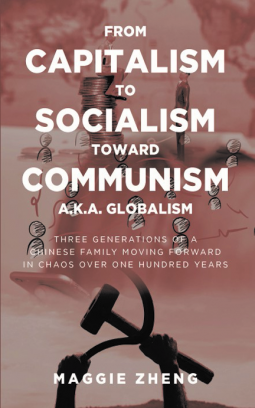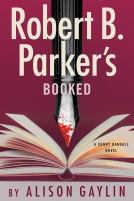
From Capitalism to Socialism toward Communism a.k.a. Globalism
Three Generations of A Chinese Family Moving Forward in Chaos Over One Hundred Years
by Maggie Zheng
This title was previously available on NetGalley and is now archived.
Send NetGalley books directly to your Kindle or Kindle app
1
To read on a Kindle or Kindle app, please add kindle@netgalley.com as an approved email address to receive files in your Amazon account. Click here for step-by-step instructions.
2
Also find your Kindle email address within your Amazon account, and enter it here.
Pub Date Sep 23 2021 | Archive Date Apr 30 2022
Description
This book was revised in March 2022 after professional editing. NetGalley reviewers can download the updated PDF file here. The paperback and salable ebook versions will be available in April 2022.
---------------------------------------
Reviewed by Linda, a former Dartmouth College composition consultant (ABT)
… I believe yours is a very important book for young people in particular, as they need to read more stories like yours about families who actually lived history. … I think your book should definitely gain readership and impress many…
Reviewed by Jack, an Amazon reader
Many books on China either read like a scroll of ideological bullet points or a hitchhiker's guide to scenic sights and hidden wonders. This book affords the reader no such luxury and immediately rolls into the life of a family that is easily relatable surviving China's most tumultuous years. …as the author's family moves back and forth between China and the U.S. through the decades, the book became an excellent reflection of the cross-cultural experience, with observations that can only be made from a perspective that can house the contradictory roles of native and foreigner at the same time. This was particularly evident in the later chapters.
Reviewed by Jitendra, a NetGalley reviewer
Before reading this book, I never knew that China was once a capitalist state, which was eventually taken over by the Communists in 1949. In addition, what tactics the CCP (Chinese Communist Party) used - … The book talks a lot about Shanghai. Shanghai was a city where people from various countries could freely come and do business before the 1940s. … I also found that Shanghai accommodated around 25K JEWs who were persecuted in Europe, and, from Shanghai, they moved to Palestine, US and other safe places…
-----------------------------------------------
This book has 4 sections, 48 chapters, and 170 images. The section titles are:
Part 1 (1920-1945) The Golden Age of Capitalism in China (12 chapters, 46 images)
Part 2 (1946-1965) The CCP turned Capitalist China into a Socialist Country (13 chapters, 44 images)
Part 3 (1966-1991) Mao's Failure at Reviving Socialism in China (12 chapters, 40 images)
Part 4 (1992-2019) The CCP implants Pseudo-Capitalism in Socialist China (11 chapters, 40 images)
------------------------------------------
Not many books have documented the complete modern history of China. This book tells that history in detail. It tells the stories of three generations of a Chinese family--Helen and George, Helen's father and uncle, and Helen's daughter, Maggie. This book records history as it is and how it happened.
In the first half of this book, China was a capitalist country. Americans had many interactions with Chinese people then. From the 1840s to 1930s, American missionaries went to China. They sponsored schools that developed into higher education there. In WWII, volunteer U.S. pilots fought side-by-side with Chinese soldiers. Many Americans know that the Chinese constructed the railroad in the 1860s. Fewer Americans are aware of another group of extraordinary Chinese. To attract Chinese students, the U.S. returned part of the indemnities for the loss in the Boxer Rebellion in Peking in 1900. The Qing Dynasty sent students to America, and they used the money for tuition. The Republic of China continued sponsoring the program until the 1940s. Helen's two brothers traveled to the U.S. to study in the 1930s-1940s. George graduated from MIT with a Ph.D. So did his two brothers. They studied science and technologies in the U.S. in the 1940s. These educated then played critical roles in banking, education, architecture, and other industries back in China. However, all life changed after the Communists took over the country.
The later chapters in this book describe how the Communists scrapped the capitalist system. Socialist ideology is now becoming a trend in the United States. Americans need to know the answers to critical questions. Did small businesses fare well in a Socialist system? Could Chinese people keep their houses and land? How about social security and medical insurance? Is the air clean? How about food safety? Would the government allow private medical practice? Have people's savings shrunk to a fraction of what they had over time? Would every worker receive compensation after completing a job? Would the government view people's lives as the priority? Why do so many parents have to separate from their children to make a living? Is there a Rule of Law? Would the government help prosecute fraudsters and scammers? Would there be abuse in preschools and schools? Are vaccine shots for children safe? Could one find a place to seek justice if something bad happened? Would the government watch everyone 24/7?
This book answers all these questions for its readers by telling real stories about real people. By simply turning the pages, readers will learn about all these historical and current scenarios and scenery in East, North, South, Northwest, Southwest, Northeast, and Central China.
Available Editions
| EDITION | Paperback |
| ISBN | 9781637101070 |
| PRICE | 36.70 |
Average rating from 5 members
Featured Reviews
 Reviewer 262225
Reviewer 262225
Before Reading this book I never knew that China was once a capitalist state. which was eventually taken over by the communists in 1949. And, what tactics the CCP ( Communist Party of China ) used -
“Taking money and food from landowners was the CCP's financing approach. It began doing it in the base of Kiangsi Soviet in the early 1930s. The CCP would push land reform as soon as it controlled an area. CCP’s members carried guns to a village. They gathered a group of rogues and wanderers, promising them food. These thugs then knocked open doors and kidnapped landlords.
The CCP would tie landlords up and parade them in the village, wearing a tall hat. Written on the hat was “I exploited poor farmers, I am guilty.” After the parade, CCP members would shoot those landlords in the head, killing them. They then searched the landlords’ houses. Taking gold, silver, and jewelry, the CCP then opened the granary. They gave the thugs a small amount of food and took the rest.”
How did the CCP win the wars ? one example is this -
“In 1948 ,CCP adopted the “body swamp ” tactics. It drove surrendered soldiers from the ROC and Japanese troops and residents. In wave after wave, the CCP pushed them to the front line of the battle. Dead bodies piled up like mountains on the front line. The ROC troops did not have the heart to continue fighting. Later, the CCP used the same tactics in Korea against American soldiers. To force the residents to the battle”
The book talks a lot about Shanghai. Shanghai was City where people from various countries could freely come and do business before the 1940s.
I also found that Shanghai accommodated around 25K JEWs who were persecuted in Europe. and, from Shanghai they moved to Palestine, US and other safe places.
I was aghast when I read that Japanese forces used poisonous gas extensively in the battle of Wuhan in 1938. I never saw this being discussed or read in the mainstream media. Maybe because the CCP committed so many atrocities that it dwarfed the Japanese atrocities.
The writing style of the book is more like fact narration. If you can ignore the grammatical errors this is a good read and gives ample understanding of Chinese history of the last 100 years. I liked it.


















